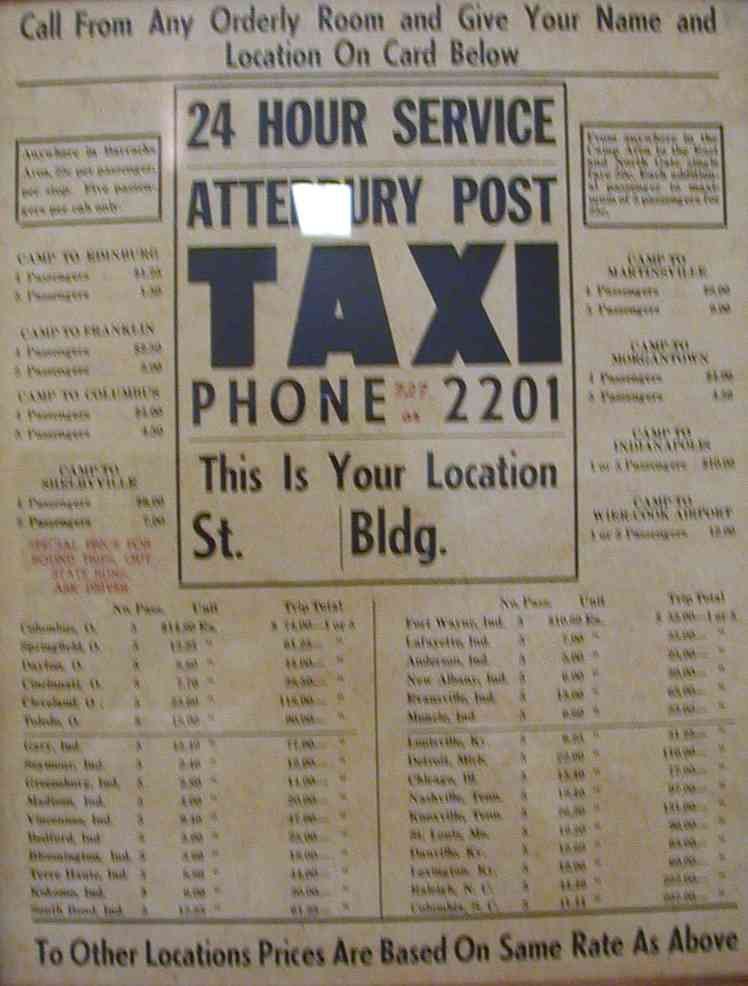|
Camp Atterbury boasts a railroad hub
of its own, containing every transportation facility, from a ticket
office to switch engine.
Rail Transportation is the official
name of this post branch, and its chief function pertains to routing and
receiving both material goods and manpower to and from Camp Atterbury.
Major C. C. Boatright, Chief, Transportation Branch, directs the
railroad's activities.
To the average soldier, Rail
Transportation means troop movements and little else - but this is only
one function of the office. Everything, by train or truck, must be
routed in or out of Atterbury by Maj. Boatright and staff, and
"there are hundreds of shipments coming and going every day."
TWO
LOCOMOTIVES
Besides receiving 25 to 40 truckloads
daily, Rail Transportation inloads carloads of coal, clothing, equipment
and other subsistence in its own "yards". Two locomotives, one
steam and the other Diesel, spot the cars to their camp destination; a
gasoline crane unloads the heave equipment.
Every item received must be checked
for damages and shortages before a bill of lading is approved and sent
to Washington, D. C., for payment. If a discrepancy is noted, a claim is
instituted against the carrier.
The movement of men is another
responsibility of Rail Transportation. This includes the supervision of
local bus and rail transportation to Indianapolis, Edinburg, Columbus,
Franklin, Shelbyville, Nineveh, Trafalgar, Morgantown and Martinsville,
in addition to "secret destinations."
Individual parties are routed daily.
each man is supplied his transportation, including Pullman, meals
enroute and route travel before leaving Camp Atterbury.
Larger shipments are troop movements.
Maj. Boatright's office can arrange shipment to any destination for any
unit within the hour and have it on it's way within three or four hours.
For such movements, the first step taken is to telephone the traffic
Control office in Washington, D. C., for routing and then arrange with
local railroads for necessary passenger, Pullman, kitchen, baggage, and
freight cars. Loading is done by the Atterbury yard crews.
EVEN A
SAWMILL
Rail Transportation has its own
packing and crating warehouse, which makes boxes to ship equipment and
blocking material. A small sawmill is in hand to supply the lumber in
any shape needed to ship a unit's property.
Before a troop train leaves the post,
its route is marked, its equipment and supplies checked and railroads
are posted. All this work is handled by a staff of 60, including 15
enlisted men. Maj. Boatright, a veteran railroad man with 29 years
service with the freight and passenger traffic departments of the Santa
Fe Railroad, directs the operation of the Atterbury hub, with the
assistance of Lt. H. K. Anderson and Lt. Robert E. Heidt.
As all over the United States, the
railroads are moving men and material, so it is in Camp Atterbury - a
day and night job, every day, every hour.
|
|
An old retired engine, long left
rusting on a sidetrack, and a veteran engineer and fireman, both of whom
had long since passed the three score mark in age, were called out of
retirement to take on the mammoth job of switching the many carloads of
materials at the camp warehouses. And they are doing a great job of it,
according to Capt. Charles G. Boatright, chief of the Transportation
branch, himself a railroader for 30 years.
With his assistant, 1st Lt. O. M.
Nordstrom, who also has had 30 years in railroading, they obtained
Engine 2490, which had been retired by the Pennsylvania Railroad.
To man it, they found a group of men,
all of whom are veterans of either the Spanish-American or World War I:
Harry E. Krause, 66 years old, of Indianapolis, Ind., with 40 years of
railroading; Engineer Bradford Ingle, 75 years old, of Indianapolis, 49
years of experience; Fireman Jack Love, 63 years old, of Indianapolis,
37 years with the rail service; Yardman David C. Williams, 55 years old,
of Morgantown, Ind., 22 years experience; Yardman Millard C. Jones of
Scipio, Ind., 23 years in the business.
|
|
A new Baldwin 120 ton Diesel engine
was recently delivered to the Post Transportation Branch here. The 1,000
hp giant is capable of pulling 70 box cars or an 18-car Pullman train
and can attain a speed of 45 mph.
Thanks to Tim Moriarty (6/2011), the
actual numbers of this diesel locomotive is now know. Number of
the Baldwin was U. S. Army 7453 and its serial number (like a VIN on
your car) was 64407. It was built in June 1942.
Roadnumber: USA 7453
Axles: 4
Type: VO-1000 diesel-electric
Serial number: 64407
Buiilt: 6/42
Builder: Baldwin Locomotive Works
There's no record yet of where it was delivered new. It's listed in BLW
field reports as being at Edinburg, IN, by 4/1947, and then to Presidio
of San Francisco by 1950.
A book I have on WW II locomotives lists USA 7453 as being at Gallup,
NM, which is probably its first location. The now-closed Fort Wingate
is to the east and south of Gallup, so I'm sure that's where it was
located prior to coming to Camp Atterbury.
Of course it could have been used in removing all the equipment, but
according to the old papers, it must have been there prior to 1947?
The BLW paperwork just notes it was there in April 1947, and a few years
later it was in California. Unfortunately we don't know exactly when it
arrived at the camp, just that it was there in 4/47 when Baldwin took
note.
Tim
|











